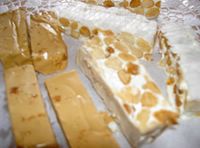 Welcome! This is Day 5 in Marg and Kailana's Advent Blog Tour. I'm going to share a little bit about how we celebrate Christmas in Montevideo, Uruguay.
Welcome! This is Day 5 in Marg and Kailana's Advent Blog Tour. I'm going to share a little bit about how we celebrate Christmas in Montevideo, Uruguay.Christmas here is probably slightly different to what most of you are used to. For starters, I know most of the readers of my blog come from the US and Canada, and so odds are you're not celebrating Christmas in 30+ ºC heat (in the nineties, in Fahrenheit)!
 Christmas celebrations for Uruguayan families typically start on the evening of the 24th, when as many members as possible of the extended family get together for dinner. This is, obviously, often subject of heated negotiations... "Last year we spent Christmas with your side of the family and New Year's Eve with mine, so this year we go to my side's on Christmas", and so on. In my case, we always get together at my uncle's (mom's brother), but it's yet to be seen if my sister's coming this year, since it's her first Christmas as a married woman.
Christmas celebrations for Uruguayan families typically start on the evening of the 24th, when as many members as possible of the extended family get together for dinner. This is, obviously, often subject of heated negotiations... "Last year we spent Christmas with your side of the family and New Year's Eve with mine, so this year we go to my side's on Christmas", and so on. In my case, we always get together at my uncle's (mom's brother), but it's yet to be seen if my sister's coming this year, since it's her first Christmas as a married woman. I should point out that this is a very small country (no point of it is separated by more than 500 km -about 300+ miles) and half the population lives in Montevideo, so it's quite easy to get the whole family together (except, of course, for the family members who've emigrated abroad. And many have, especially after the big crisis we had some 4 years ago).
Presents don't arrive on Christmas morning, but on the afternoon or evening of the 24th. If there are small children in the family, there's always some big production to make them believe Santa (or Papá Noel, as we call him) really did come. Like, one year mom took us to visit a couple of distant relatives before we went to our uncle's, and when we got home, all the furniture in the living room had been overturned and the presents were strewn about among it. Dad told us Santa had been running late, so he'd banged into the furniture in his hurry to leave all the gifts.
These days, my youngest cousin is 17, so we simply deposit all the presents under the Christmas tree when we arrive at my uncle's, and simply exchange them after dinner, opening them all in turn, among much oohing and aahing.
 Dinner itself varies a lot among families, but it's most common to first eat a "picada", which is a bit like the Spanish "tapas": a variety of hors d'oeuvres and snacks. Then it's the main course, which is often either some kind of buffet or an "asado", a barbecue. The most common thing to eat is "lechón", suckling pig, and sometimes also lamb.
Dinner itself varies a lot among families, but it's most common to first eat a "picada", which is a bit like the Spanish "tapas": a variety of hors d'oeuvres and snacks. Then it's the main course, which is often either some kind of buffet or an "asado", a barbecue. The most common thing to eat is "lechón", suckling pig, and sometimes also lamb.Dinner starts late, at around 10 PM (we always dine late, but it's often even later on Christmas, because many of the guests have to pay visits before arriving), so dinner is usually just ending at midnight, when Christmas Day starts. At that point, everyone gets a glass of champagne or cider (yep, even the kids, though if they're very young, they get just the bottom of their glasses) and we all go around the table clinking glasses with everyone else, exchanging kisses and exclaiming "Feliz Navidad!" over and over again.
 Immediately after that, all hell breaks loose. The phones start ringing (friends, family, boyfriends and girlfriends who aren't there, calling to say Feliz Navidad... the mobile phone networks always collapse at midnight), and fireworks start to go off all over the city, covering the sky with sparks and lights. And when I say a lot, I mean a lot. Last year the show was still going on at half past midnight.
Immediately after that, all hell breaks loose. The phones start ringing (friends, family, boyfriends and girlfriends who aren't there, calling to say Feliz Navidad... the mobile phone networks always collapse at midnight), and fireworks start to go off all over the city, covering the sky with sparks and lights. And when I say a lot, I mean a lot. Last year the show was still going on at half past midnight. It looks pretty, but I'm not much of a fan of this custom. For starters, it can be a bit dangerous... there are always people admitted to the emergency room that night who had one go off in their hand, and they lose fingers or even sometimes an eye.
Also, just thinking about the amount of money that gets burnt in that half hour makes my miserly little soul shrivel a little bit. Those suckers are NOT cheap! Actually, I have a theory, which I'm going to have to develop for work, that one could use the length of time the fireworks continue and their intensity as a predictor of economic activity, or at least, of the private sector's expectations. During the crisis I mentioned earlier, in 2002, it was like 5 or 10 minutes, a very piddling show. But once the economy started to go well again, that went up exponentially. Last year was the longest and most intense I ever remember seeing.
 Ahem, sorry for the economic disgression. Then, after watching the fireworks, comes dessert, which can vary, but is usually ice cream. But whatever the dessert is, it's always accompanied by "turrón" and "pan dulce", which basically combines the two most common Uruguayan ancestries, Spanish and Italian.
Ahem, sorry for the economic disgression. Then, after watching the fireworks, comes dessert, which can vary, but is usually ice cream. But whatever the dessert is, it's always accompanied by "turrón" and "pan dulce", which basically combines the two most common Uruguayan ancestries, Spanish and Italian.Turron is what you see to the left. I think it might be translated as nougat, in English. It's a kind of confectionery made of sugar or honey and roasted nuts. In the good ones, the nuts in question are almonds, walnuts, pistachios or hazelnuts, but many Uruguayans go for the cheaper, domestically-made versions, which use peanuts.
On the photo you can see two kinds. The one on the left is soft and oily, while the one on the right has caramelized sugar, so sometimes you can endanger your teeth biting into it! Turrón is typical both of Spanish and Italy, but the variety you see most often here is in the Spanish tradition.
 On the photo on the right you can see a "pan dulce". That translates as "sweet bread", literally, but it's NOT a meat product (though we do eat sweetbreads here, and if dinner was a barbecue, we probably did eat some grilled sweetbreads -which we call "mollejas"- as part of the "picada").
On the photo on the right you can see a "pan dulce". That translates as "sweet bread", literally, but it's NOT a meat product (though we do eat sweetbreads here, and if dinner was a barbecue, we probably did eat some grilled sweetbreads -which we call "mollejas"- as part of the "picada"). Our "pan dulce" is basically the Italian pannetone, a kind of dome-shaped sweet bread, containing all kinds of candied fruits and roasted nuts.
 After eating like pigs (we really should eat a bit lighter, not what our forefathers used to eat in the old country. It was winter there and they needed the calories!) the young separate from the old(er). The members of the older generation just stay chatting for a while longer (it's about 2 in the morning by then) and go to bed, while the teens and twenty-somethings go partying.
After eating like pigs (we really should eat a bit lighter, not what our forefathers used to eat in the old country. It was winter there and they needed the calories!) the young separate from the old(er). The members of the older generation just stay chatting for a while longer (it's about 2 in the morning by then) and go to bed, while the teens and twenty-somethings go partying.There are always some very big parties on Christmas, and it's one of the days of the year in which more people go out (the day most people go out is on August 24th, Nostalgia Night, when they play oldie hits everywhere, but that's another story). Most people go out in couples, and getting a date for the Christmas parties is a very big deal, and often decided weeks in advance.
This is actually another part of our Christmas that, like the fireworks, is quite dangerous. Most of the parties are what we call "canilla libre" (free tap or faucet), which is a way of saying that they're all-you-can-drink. Which, of course, means there are a lot of drunken people driving around at 6 or 7 in the morning, when the parties end. The police tries to stop this, with Breathalyzer tests and awareness campains beforehand, but there are always at least a couple of big accidents that night, and a few people who die. *sigh*
Ok, back to happier stuff. On Christmas day itself families usually get together again, and it's kind of a mix and match thing. If you went to a certain side of the family's place the evening before, you go to the other's that day. The food is usually leftovers from the night before, or else, something easy to cook, and the mood is more subdued (possibly because the kids are all hungover).
And well, that's about it. This turned out to be much longer than I'd planned (like that's a surprise! I know I'm longwinded), so thank you if you've read this far, and I hope you found it interesting.
Feliz Navidad to everyone!
No comments:
Post a Comment